DMP Electronics Wiegand 734N Installation guide
- Category
- Security access control systems
- Type
- Installation guide

734N Wiegand Interface Module
Description
The 734N Wiegand Interface Module
allows you to add IP network access
control capability to XR100/XR500, XR150/
XR550, and XR150INT/XR550INT Series
panels using proximity or mag-stripe card
readers. The 734N provides a fast, safe
and secure 10/100 Mbps connection to
your local network for AES encrypted TCP
communication with the control panel. It
also allows fast verication of user codes
presented at the reader for door access.
Four input zones are provided to allow
connection of nearby burglary devices.
For local annunciation, a programmable
speaker and a variety of switched ground
annunciators are provided to connect
sounders. In addition, he 734N provides
LEDs to indicate door strike, Wiegand
inputs, and power to the module.
The 734N provides a keypad programming connection to use a standard DMP LCD keypad for initial network setup.
Programming can be completed using the keypad or from the panel.
Mounting the 734N
The 734N ships installed in a decorative, high-impact plastic housing that mounts directly to walls, backboards, or
other at surfaces. For easy installation, the 734N housing back and ends have wire entrances. The bottom contains
multiple screw holes for mounting on single-gang switch boxes. It is recommended to mount the 734N near the
protected door.
Magnetic Lock and Door Strike Wiring
Control door strikes and magnetic locks by using the Form C relay on the 734N module. Use an additional power
supply to power door strikes and magnetic locks. Refer to Figures 2 and 3 for wiring information.
Normally
Closed
Magnetic Lock
Model 333
Supressor
–+
12/24VDC
Power
Supply
734N
Interface
Module
DC Input
Figure 2: 734N Magnetic Lock Wiring
Model 333
Supressor
Normally
Open
–+
DC Door Strike
12/24VDC
Power
Supply
734N
Interface
Module
DC Input
Figure 3: 734N Door Strike Wiring
Figure 1: 734N Wiegand Interface Module
734N
Interface
Module
Door Relay Wiegand Inputs
Network
Connection
Zones
Piezo
Reset Header
Green
Power
LED
Yellow
Wiegand
LED
Red
Door Strike
LED
Green
LED
Yellow
LED
DC Input
Annunciator Outputs
INSTALLATION GUIDE

Digital Monitoring Products 734N Installation Guide
2
Network Connection
Connect an IP network cable from the LAN/WAN connection to the 734N Network connector. The 734N communicates
AES encrypted TCP with panels with Network installed.
Two LED's are located on the ethernet jack.
• The green LED indicates data sent to the panel.
• The yellow LED indicates the speed of the transmission. A solid yellow LED indicates the network is connected
at 100 Base-T. A ashing yellow LED indicates the network is connected at 10 Base-T.
NO/C/NC (Dry Contact Relay)
The 734N provides a Form C (SPDT) relay for controlling door strikes or magnetic locks. The three relay terminals
marked NO C NC allow you to connect the device wiring to the relay for module control. See Figures 2 and 3 for
proper door strike and magnetic lock wiring.
The Form C relay draws up to 35mA of current and contacts are rated for 10 Amps (resistive) at 12/24VDC.
When connecting multiple locks to the Form C relay, the total current for all locks cannot exceed 10 Amps. If the
total current for all locks exceeds 10 Amps, problems may arise and an isolation relay may be needed.
See the Isolation Relay section for information.
Install the 333 Suppressor
One Model 333 Suppressor is included
with the 734N module. Install the
suppressor across the 734N Common (C)
and Normally Open (NO) or Normally
Closed (NC) terminals.
If the device being controlled by the
relay is connected to the NO and C
terminals, install the suppressor on the
NO and C terminals. Conversely, if the
device is connected to the NC and C
terminals, install the 333 Suppressor on
NC and C terminals.
The suppressor wire is non-polarized. Install the suppressor as shown in Figure 4.
Isolation Relay
The Form C Relay can control a device that draws less than 10 Amps of current. If a device draws more than 10 Amp
of current, or the sum of all devices controlled by the Form C Relay exceeds 10 Amps, an isolation relay must be used.
Refer to Figures 5 and 6 for isolation relay wiring.
734N
Interface
Module
Model 333
Supressor
Model 333 Suppressor
Wire the Suppressor to the Common and Normally
Open or Normally Closed depending upon which
terminals are used for the device.
Figure 4: Model 333 Installation on the 734N Module
Figure 5: Isolation Relay with Magnetic Lock Figure 6: Isolation Relay with Door Strike
Normally
Open
Normally
Open
–+
DC Door Strike
–+
Isolation Relay
12/24VDC
Power
Supply
NCCNO
Model 333
Supressor
Normally
Closed
Normally
Open
–+
Magnetic Lock
–+
Isolation Relay
12/24VDC
Power
Supply
NCCNO
Model 333
Supressor

734N Installation Guide Digital Monitoring Products
3
Connection to Reader
Figure 7 shows a reader with wire colors red, white,
green, and black. The wire colors may be different for
the reader being installed. Connect the reader wires to
terminals 1, 2, 3, and 4. As shown in Figure 7, the green
wire carries D0, or Data Zero, and the white wire carries
D1, or Data One. The red wire carries 12/24VDC, 200mA
power limited output and the black wire is ground.
Status LEDs
The 734N provides three status LEDs and two ethernet
LEDs. See Figure 1 for locations of the LEDs.
• The red LED turns on for the duration of the door strike.
• The yellow LED turns on for one second to indicate a Wiegand read.
• The green LED is constant to indicate power.
Zone Terminals
Terminals 5-11 connect grounded zones 1 through 3. These zones have
a grounded side and cannot be used for re-initiating devices. Zones
2 and 3 can also be used for access control with Zone 2 providing a
bypass option and Zone 3 providing Request to Exit functionality. Zone 4
terminals provide a non-powered Class B, Style A zone. Use the supplied,
DMP Model 311 1K Ohm End-of-Line resistors on each zone. Refer to the
panel programming guide for programming instructions.
Zone # Recommended Device Residential Fire Devices?
1 Any burglary device No
2 Door Contact No
3 REX (PIR or Button) No
4 Any device Yes
Annunciator Header
The 4-pin header located on the far right of the circuit board is used to wire the Armed Status, Remote
Annunciation, and the Remote LED Control
. The open collectors supply a ground for a maximum current of 50mA
@
30VDC.
Connect a Model 300 4-wire harness to the 4-pin header for connection of the following indicators:
--
AS (Armed Status)
Armed Status provides an unsupervised switched ground for a visual or
audible armed status indicator that turns on when the burglary areas are
armed, such as SYSTEM ON or ALL SYSTEM ON. Connect the wire from the
4-wire harness to an Armed Status output.
--RA (Remote Annunciation)
Remote Annunciation provides an unsupervised switched ground for a remote
annunciator that turns on when the 734N on-board piezo turns on.
Connect
the wire from the 4-wire harness to a
remote annunciator. The remote
annunciator silences when the RA restores. The remote annunciator (RA)
switched ground operates even if the speaker is programmed not to operate.
--LC (Remote LED Control)
Remote LED Control provides an unsupervised switched ground for a visual indicator that turns on when the 734N
relay activates. Connect the wire from the 4-wire harness to an LED. The LED turns on for the duration the door
strike relay is on. HID readers optionally provide a connection for LED reader control.
Auxiliary Outputs 1 & 2
The 734N controls Auxiliary Outputs 1 and 2 when the Activate Zone 2 Bypass
programming option is enabled and the Zone 2 Bypass Time is set. When the door
contact (Zone 2) is opened while the door strike is activated, the Zone 2 Bypass Time
starts. If the door has not closed at the end of the timer, Aux Output 1 is turned on
and the timer starts again. If the door is still open at the end of the second timer, Aux
Output 2 is turned on. Aux Outputs 1 and 2 turn off when the door contact is closed.
Use the Model 431 Relay Harness for connection of Output 1 and Output 2 as shown in
Table 1.
Figure 7: Card Reader Wiring
734N Interface Module
12/24VDC
Card Reader
Red
White (Data 1)
Black
Green (Data 0)
Shield
734N Interface Module
Zone 1
Zone 2
Zone 3
Zone 4
Note: Use 1K Ohm EOL for each zone.
Figure 8: 734N Zone Terminals
Remote Audible Annunciator
Armed Status Output
Output 2
Output 1
Remote LED Control
Figure 9: 734N Annunciator Outputs
Form C Relays (J2)
Output Color Code–Model 431 Harness
Output 2 N/O Orange/White
Output 2 Com White/Gray
Output 2 N/C Violet/White
Output 1 N/O Orange
Output 1 Com Gray
Output 1 N/C Violet
Table 1: Harness Wiring

Digital Monitoring Products 734N Installation Guide
4
Reset Header
The reset header is located just above and to the right of the network connector (see Figure 1) and is used to reset the
734N module. To reset the module when rst installing the system, short the two pins on the reset header before applying
power to the module.
To reset the module while the system is operational, short the two pins on the reset header for one or two seconds without
powering down the system.
Addressing the 734N
Keypad Bus Addresses
DMP XR550 Series panels use keypad bus addresses 2 through 16. XR150 Series panels can only use keypad bus addresses 2
through 8. Address 1 is reserved for hardwired keypads on both XR150 and XR550 Series panels. Each keypad bus address
can accommodate 1 door output and 4 expansion zones. The 734N operates using addresses 2-16, with address 1 being
reserved for panel keypad operation. A 734N with an address of 2 on the keypad bus would represent Door 2 and zones 21-
24. A 734N with a keypad address of 14 would represent Door 14 and zones 141-144.
AX-Bus Addresses (XR550 only)
DMP XR550 panels are capable of access control expansion using any of the ve AX/LX-Bus headers (AX/LX500, 600, 700,
800, and 900). An AX-Bus address can accommodate 1 door output and 1 expansion zone. Because the 734N has a built-in
4-zone expander, 3 extra zones must be mapped to the 734. A 734N with an address of 501 on AX500 would represent Door
501 and zones 501-504. A 734N with an address of 505 on AX500 would represent Door 505 and zones 505-508. A 734N with
an address of 701 on AX700 would represent Door 701 and zones 701-704.
Note: Hardwired zone expanders and addressable points and modules do not communicate on an AX-Bus. AX-Bus doors do
not have programmable device or communication types and do not have assignable display areas.
Setting the 734N Addresses
To set the 734N address, refer to Table 2.
Only valid door numbers can be assigned to 734Ns in device setup. For complete keypad and AX-Bus address mapping, see
the chart below.
Table 2: Device Addresses and 734N Zone Numbers
Device/
Door
Zones
Device/
Door
Zones
Device/
Door
Zones
Device/
Door
Zones
Device/
Door
Zones
Device/
Door
Zones
501 501-504 601 601-604 701 701-704 801 801-804 901 901-904
2 21-24 505 505-508 605 605-608 705 705-708 805 805-808 905 905-908
3 31-34 509 509-512 609 609-612 709 709-712 809 809-812 909 909-512
4 41-44 513 513-516 613 613-616 713 713-716 813 813-816 913 913-916
5 51-54 517 517-520 617 617-620 717 717-720 817 817-820 917 917-920
6 61-64 521 521-524 621 621-624 721 721-724 821 821-824 921 921-924
7 71-74 525 525-528 625 625-628 725 725-728 825 825-828 925 925-928
8 81-84 529 529-532 629 629-632 729 729-732 829 829-832 929 929-932
9 91-94 533 533-536 633 633-636 733 733-736 833 833-836 933 933-936
10 101-104 537 537-540 637 637-640 737 737-740 837 837-840 937 937-940
11 111-114 541 541-544 641 641-644 741 741-744 841 841-844 941 941-944
12 121-124 545 545-548 645 645-648 745 745-748 845 845-848 945 945-948
13 131-134 549 549-552 649 649-652 749 749-752 849 849-852 949 949-952
14 141-144 553 553-556 653 653-656 753 753-756 853 853-856 953 953-956
15 151-154 557 557-560 657 657-660 757 757-760 857 857-860 957 957-960
16 161-164 561 561-564 661 661-664 761 761-764 861 861-864 961 961-964
Note: The 734N is a supervised module and cannot operate in unsupervised mode.

734N Installation Guide Digital Monitoring Products
5
PROG (Programming)
To program a 734N you must complete the programming process in two places: the panel and the 734N. First, refer to the
Network Options and Device Setup sections of the XR150/XR550 Series Programming Guide (LT-1232) to set up the device in
the panel. Then, step through the programming directions below to program the 734N.
The rst time a 734N is programmed, you must use a 32-character keypad connected directly to the 734N and set to
address one. For 12 Volt applications, connect the keypad to the module using a Model 330 4-wire harness. For 24 Volt
applications, connect the keypad to the module using a 330-24 4-wire programming harness with an in-line resistor. While
in programming mode, no 734N communication with the panel can occur.
Caution: Do not connect a keypad using a Model 330 harness if you are using a 24 volt power supply! Damage to the
keypad could occur.
Note: Before programming the 734N, obtain the Service Set Identication (SSID), the Wireless Security Type, and the
Wireless Network Key from the router or a network administrator.
Version Display
When you connect the keypad to the 734N module, the version number and release
date display.
• Press keys 1, 2, 3, or 4 then the CMD key to show zone status of that zone.
• Press CMD key to enter the Diagnostic Menu.
• Press 6653 (PROG) then CMD to enter the Programming Menu.
Zone Status Display
The status of the entered zone number displays. To display another zone, enter the
zone number followed by the CMD key.
Diagnostic Menu
Select YES to display the Panel Communication Connect Status display. Select NO to
return to Version Display.
Connect Status
To display the connection status of the 734N to the panel, select any top row key.
Not Connected: The 734N cannot connect to the panel on the network.
Bad Passphrase: The passphrase programmed in the 734N device does not match the passphrase
programmed in the panel.
Device Not Programmed: The device number programmed in the 734N is not programmed as a
Device Number in the panel.
Duplicate Device: There is another device on the network with the same device number.
Transmit Time XXX: The speed in milliseconds in which the last message was sent and received
between the 734N and the panel.
Programming Menu
Press the CMD key to enter programming and display initialization options.
Initialization Options
These options can set the 734N module programming memory back to factory defaults
in preparation for programming. Press any select key to enter the initialization menu.
Initialization Communications
Select YES to initialize the communication options back to factory defaults. Select NO to
leave communication options unchanged.
Initialize Conrm Option
After selecting YES to clear the Communication settings, the 734N displays SURE? YES NO
for conrmation to clear the memory. This is a safeguard against accidentally erasing the
programming. No memory is cleared from the programming until you answer YES to the
SURE? option. Selecting NO leaves communication options unchanged.
Initialization Access
Select YES to initialize the Access Options back to factory defaults. Select NO to return to
the INITIALIZATION menu.
734N
VER 101 02/01/17
734N DOOR
ZONE: 2 -OPEN
734N REX
ZONE: 3 -SHORT
734N
ZONE: 1 -OKAY
MENU? NO YES
CONNECT STATUS
CONNECT STATUS
NOT CONNECTED
CONNECT STATUS
BAD PASSPHRASE
CONNECT STATUS
DEVICE NOT PROG
CONNECT STATUS
DUPLICATE DEVICE
CONNECT STATUS
XMIT TIME xxx mS
734N
PROGRAMMER
734N
INITIALIZATION
INITIALIZATION
COMMS? NO YES
INITIALIZATION
SURE? YES NO
INITIALIZATION
ACCESS? NO YES

Digital Monitoring Products 734N Installation Guide
6
INITIALIZATION
SURE? YES NO
Initialize Conrm Option
After selecting YES to clear the Access Options, the 734N displays SURE? YES NO for
conrmation to clear the memory. This is a safeguard against accidentally erasing the
programming. No memory is cleared from the programming until you answer YES to the SURE?
option. Selecting NO
leaves communication options unchanged.
734N
COMMUNICATION
Communication Menu
Press any select key to enter the Communication menu. Press the CMD key to advance to
the Access Options menu. Press the back arrow to display the 734N Initialization menu.
734N DEVICE NO:
7
734N Device Number
Enter a device number from 2-16 for the 734N. The device number must also be
programmed as a device in the panel. Default is 7.
734N
DHCP? NO YES
734N DHCP
Select YES (fourth select key) to use dynamic IP address information for the 734N IP
Address, Subnet Mask, and Gateway Address. Select NO (third select key) to enter static
IP information.
734N IP ADDRESS:
192.168.0.201
734N IP Address
Enter the static IP address of the 734N if the DHCP is set to NO. Default is 192.168.0.201.
SUBNET MASK:
255.255.255.0
Subnet Mask
Enter the local subnet mask assigned to the 734N. Default is 255.255.255.0
GATEWAY ADDRESS:
192.168.0.1
Gateway Address
Enter the local gateway address of the 734N. Default is 192.168.0.1
PANEL IP ADDR:
0.0.0.0
Panel IP Address
Enter the IP address of the panel. Default is 0.0.0.0.
Note: This IP address must match the address programmed in the panel at the Local IP
Address option in Network Options. The DHCP programming in the panel must be set to NO.
PANEL IP PORT:
2002
Panel IP Port
Enter the port number that the 734N uses to send communication to the panel. This must
be the same port that is programmed in 734N Listen Port in Network Options programming
of the panel.
Note: The Panel IP Port cannot be the same as the panel network programming port.
734N PASSPHRASE
734N Passphrase
Enter an 8 to 16-character alphanumeric Passphrase to encrypt communication with the
panel. The 734N Passphrase must match the 734N Passphrase entered in Network Options
programming of the panel. The Passphrase is blank by default.
Note: A passphrase is required for communication to occur with the panel.
734N
ACCESS OPTIONS
Access Options
Press any select key to enter the Access Options menu. Press the CMD key to advance to the
Stop option. Press the back arrow to display the Communication menu.
ACTIVATE ZONE 2
BYPASS? NO YES
Activate Zone 2 Bypass
Select YES to activate the Zone 2 Bypass operation. Selecting NO allows standard zone
operation on Zone. Default setting is NO.
If the door being released by the 734N module is
protected (contact installed), you can provide a programmable bypass entry/exit timer by
connecting its contact wiring to the 734N module Zone 2. When the on-board Form C relay
activates and the user opens the door connected to Zone 2, the zone fault is delayed for the
number of seconds programmed in ZONE 2 BYPASS TIME allowing the user to enter/exit during
an armed period.
If Zone 2 does not restore (door closed) within the programmed time, the piezo sounds
every other second during the last ten seconds. If Zone 2 restores prior to the end of the
programmed time, the piezo silences. If the zone does not restore before the programmed
time, the 734N ends the bypass and indicates the open or short zone condition to the panel.
ZONE 2 BYPASS
TIME: 40
Zone 2 Bypass Time
Enter the number of seconds to elapse before the Bypass Timer expires. Range is from 20
to 250 seconds. Press any top row select key to enter the number of seconds. If the door
remains open when the timer expires a zone open/short is sent to the panel for Zone 2.
The default is 40 seconds. Figure 10 shows how the Bypass option works.

734N Installation Guide Digital Monitoring Products
7
RELOCK ON ZONE 2
CHANGE? NO YES
Relock on Zone 2 Change?
Selecting YES turns the relay off when Zone 2 returns to normal during the bypass. Selecting
NO leaves the relay on when Zone 2 faults to an open or short condition during bypass.
Turning off the relay at Door Closed allows a long strike time to be automatically ended and
relocks the door. The default is NO.
ACTIVATE ZONE 3
REX? NO YES
Activate Zone 3 Request to Exit
Selecting YES activates the Zone 3 Request to Exit (REX) option.
Selecting NO allows standard zone operation on Zone 3. Default setting is NO.
Connect a PIR (or other motion sensing device) or a mechanical switch to Zone 3 to provide
REX capability to the system.
When Zone 3 shorts, the on-board Form C relay activates for the programmed number of
seconds (see Zone 3 REX Strike Time). During this time, the user can open the protected
door to start the programmed Zone 2 Bypass entry/exit timer. After the programmed
number of seconds, the relay restores the door to its locked state.
The 734N module provides a bypass-only option for REX on Zone 3. When Zone 3 OPENS
from a NORMAL state, only a bypass occurs: the on-board relay does not activate. This
bypass-only option uses two methods of REX. The rst REX device provides the programmed
bypass entry/exit timer. The second REX, or manual device such as a door knob, unlocks
the door.
An example of the shunt-only conguration is a door to an ofce that is locked 24 hours
a day. Users pass a REX motion detector positioned by the door to begin the programmed
exit timer. Within the programmed number of seconds the user must then manually
activate a second device, such as a REX device or manual door knob, to unlock the door.
If the door is opened after the programmed number of seconds, an open condition is
indicated to the panel.
ZN 3 REX STRIKE
TIME: 5
Zone 3 REX Strike Time
Enter the number of REX seconds to elapse. Range is from 5 to 250 seconds. Press any
select key to enter the number of seconds. The default is 5 seconds.
ACTIVATE ONBOARD
SPEAKER? NO YES
Activate Onboard Speaker
Select YES to enable the onboard speaker for local annunciation, such as alarm and trouble
annunciations. Select NO to turn the speaker off for all operations. This does not affect
remote annunciator open collector (RA) operation. The default is NO.
Card Options
Typically, an access card contains data bits for a site code, a user code, and start/stop/
parity bits. The starting position location and code length must be determined and
programmed into the 734N Module. Select DMP to indicate the reader sends a 26-45 bit data
string. To select the DMP option, press the rst Select key under DMP. Default is DMP.
Select CUSTOM if using a non-DMP card with a user code length of 4 to 12 digits.
Select ANY to allow all card reads to activate the door strike relay. The door strike relay is
activated for the length of time programmed in ZN 3 REX TIME. No user code information is
sent to the panel.
Note: When set to DMP, the 734N converts 17 bits of the 26 to 45-bit data string into a
5-digit number.
CARD OPTIONS:
DMP
CARD OPTIONS:
DMP CUSTOM ANY
01110101101101010001100111
First Bit
Received
Position = 1
Site Code
Position = 2
Length = 8
User Code
Position = 9
Length = 16
Last Bit
Received
Position = 26
In this example the Wiegand Code Length = 26 bits.
Figure 11: HID 26-bit Wiegand Data Stream Bit Location
5 Second
Strike
40-Second Zone 2 Bypass
entry/exit timer.
10 seconds before
the bypass time expires,
the device beeps if
the door is still open.
End of
timer.
40
Seconds
A zone open/short is
indicated if the door
remains open.
Figure 10: Zone 2 Bypass Timeline using default time

Digital Monitoring Products 734N Installation Guide
8
Custom Card Denitions
Wiegand Code Length
When using a custom product, enter the total number of bits to be received in Wiegand
code including parity bits.
Press any top row Select key to enter a number between 1-255 to equal the number of bits.
Default is 26 bits.
Site Code Position
Enter the site code start position in the data string. Press any Select Key to enter a number
between 0-255. Default is 1. Press the CMD key to save the entry.
SITE CODE
LENGTH: 8
Site Code Length
Enter the number of Site Code bits used.
Press any Select Key to enter a number between
1-16. Default is 8. Press the CMD key to save the entry.
USER CODE
POSITION: 9
User Code Position
Dene the User Code start bit position. Press any Select Key to enter a number between
0-255. Default is 9. Press the CMD key to save the entry.
USER CODE
LENGTH: 16
User Code Length
Dene the total number of User Code bits used. Press any Select Key to enter a number
between 1-255. The default is 16.
REQUIRE SITE
CODE: NO YES
Require Site Code
Press the top row Select key under YES to use a site code and press the CMD key to
view the site code entry display. In addition to User Code verication, door access is only
granted when any one site code programmed at the SITE CODE ENTRY option matches the
site code received in the Wiegand string.
Site Code Display
You can program up to eight ve-digit site codes. Site code range is 1-65535.
SITE CODE 1 displays rst. Any previously programmed site code displays. Default is 127.
To change the site code, press a select key, then enter the new code. Press the CMD
key to save and to display the next site code.
Site Codes 2-8 default to blank.
NO. OF USER CODE
DIGITS: 5
Number of User Code Digits
The 734N module recognizes user codes from one to ten digits in length. Press any top row
Select key to enter a user code digit length between 3-12 digits. This number must match the
user code number length being programmed in the panel. Default is 5.
All bits are read and converted into a decimal number string. The number string is left
padded with '0' if needed for long user code lengths. When selecting '4' the right digit is
dropped and the next four sent.
Example: # decoded 1234567
10 digits 0001234567
5 digits 34567
4 digits 3456
No Communication with Panel
This option denes the relay action when communication with the panel has not occurred
for approximately ten seconds. Default is OFF. Press any top row Select key to change the
default relay action.
Choose the action required when the 734N cannot establish communication with the panel:
Press the rst Select key to choose OFF (Relay Always Off) — The relay does not turn on
when any Wiegand string is received. OFF does not affect any REX operation.
If communication is lost during a door strike, relay remains on for the door strike duration,
but turns off at the end of the door strike timer.
Press the second Select key to choose SITE (Accept Site Code) — Door access is granted
when the Wiegand site code string received matches any site code programmed at SITE
CODE 1-8. For details refer back to the REQUIRE SITE CODE option.
Press the third Select key to choose ANY (Any Wiegand Read) — Door access is granted when
any Wiegand string is received.
Press the fourth Select key to choose ON (Relay Always On) — The relay is always on.
Press the CMD key to display the next action.
Press the rst Select key to choose LAST (Keep Last State) — The relay remains in the same
state and does not change when communication is lost. If communication is lost during a
door strike, the relay remains on for the door strike duration, but then returns to it's last
state prior to doing the door strike.
734N
STOP
Stop
Press any select key to start the stop routine. When programming in complete, the Version
displays and the keypad can now be removed.
WIEGAND CODE
LENGTH: 26
SITE CODE
POSITION: 1
SITE CODE 1:
(1 - 65,535) 127
SITE CODE 2:
(1 - 65,535) -
SITE CODE 8:
(1 - 65,535) -
NO COMM WITH PNL
OFF
NO COMM WITH PNL
OFF SITE ANY ON
NO COMM WITH PNL
LAST

734N Installation Guide Digital Monitoring Products
9
734N Network Specications
The 734N was designed to have minimum impact on network performance. The 734N is supervised in the panel by
exchanging two data packets every ve seconds. The payload of the data packets exchanged between the XR100/XR500,
XR150/XR350/XR550 or the XR150INT/XR350INT/XR550INT Series and the 734N is a very small 18 bytes. The total trafc for
all supervision, including network overhead, is roughly two kilobytes per minute per 734N. This would be equivalent to a
very small e-mail message.
If required, all of the trafc between the 734N(s) and the panel can be completely isolated from the rest of the existing
network by connecting all of the 734N modules and the panel to the same switch, then connecting the switch to the
remainder of the network. All trafc between the 734N and the panel would then be conned to the switch where they are
connected, while still allowing the panel to communicate with the central station through the normal network.
The security of the 734N is multi-faceted. Most importantly, the 734N is a single purpose network device. What this means
is that all of the ports in the TCP/IP stack used in the 734N are disabled and allow no inbound connections. This prevents
a potential intruder from making any type of connection with the 734N through the network. The 734N communicates with
the control panel by establishing an outbound only connection to the panel. All communication between the 734N and the
control panel is encrypted using 128-bit AES encryption. This is the same encryption standard approved and used by the
U.S. government, including the National Security Agency for encrypting Secret information.
Packet Communication Outline:
• The 734N module establishes panel communication using the TCP/IP protocol.
• At start up, the 734N opens a TCP/IP connection that remains open indenitely.
• The socket can be closed by the 734N or panel after a time-out.
• The connection is re-established by the 734N after the time-out.
• A pair of supervision packets are sent every 5 seconds.
- The payload for each packet is 18 bytes and the total trafc, including overhead, is approximately 2 kilobytes
per minute for each 734N.
- Non-Supervision messages have a payload range of 18-50 bytes.
Compliance Listing Specications
UL Access Control
The access relay must be congured as fail-safe or fail-secure as determined by the local Authority Having Jurisdiction
(AHJ). This system is not intended to be used in place of listed panic hardware.
The power supply must be a listed commercial burglary/household re, power limited, Class 2 with a compatible voltage
range for the product. The 734N requires a listed 12 or 24VDC power source.
ULC Commercial Burglary (XR100/XR500 and XR150/XR350/XR550 Series Panels)
When using the zones of the 734N in a listed application, place the module in a listed enclosure and connect a DMP Model
307 Clip-on Tamper Switch to the enclosure programmed as a 24-Hour zone.
The 734N Access Control features have not been investigated by ULC.
The 734N zones can be used in a Low Risk application. For Medium or High Risk applications, refer to the Dual Zone
Protection diagram in the XR100/XR500 or XR150/XR350/XR550 Canadian installation guides.

LT-1197 1.03 © 2017 Digital Monitoring Products, Inc.
17072
800-641-4282
INTRUSION • FIRE • ACCESS • NETWORKS
www.dmp.com 2500 North Partnership Boulevard
Designed, Engineered and
Assembled in U.S.A.
Springeld, Missouri 65803-8877
Specications
Primary Power 8.5VDC to 28.5VDC
Current Draw
Standby 346mA (Includes 200mA for
Proximity Reader)
+ 1.6mA per active zone
Alarm 348mA (Includes 200mA for
Proximity Reader)
+ 10mA with Annunciator ON
+ 2mA per faulted zone
Form C Relay 35mA at 12/24VDC
Zones 5VDC, 2mA max
Dimensions 4.5” W x 2.75” H x 1.75” D
Weight 8 oz .23 Kg
Compatibility
XR150/XR550 Series panels
XR150INT/XR550INT Series panels
Accessories
Proximity Readers
PP-6005B ProxPoint
®
Plus Proximity Reader
MP-5365 MiniProx™ Proximity Reader
PR-5455 ProxPro
®
II Proximity Reader
MX-5375 MaxiProx
®
Proximity Reader
TL-5395 ThinLine II
®
Proximity Reader
Proximity Credentials
1306P DMP Prox Patch
1306PW Prox Patch™
1326 ProxCard II® Card
1346 ProxKey III® Access Device
1351 ProxPass®
1386 ISOProx II® Card
Certications
FCC Part 15
California State Fire Marshall (CSFM)
NIST AES Algorithm Certicate #1937
ANSI/UL 294 Access Control System Units
ANSI/UL 1610 Central-Station Burglar-Alarm Units
ANSI/UL 609 Local Burglar Alarm Units And Systems
ANSI/UL 1076 Proprietary Burglar Alarm Units And
Systems
ANSI/UL 1023 Household Burglar-Alarm System Units
ULC S304 Central And Monitoring Station Burglar
Alarm
ULC C1076 Proprietary Burglar Alarm Units And
Systems
ULC C1023 Household Burglar Alarm System Units
International Certications
Security Grade: 3
Environmental Class: II
Intertek (ETL)
EN 50130-4 EMC Product Family Standard: Immunity
Requirements for Componenets of Fire,
Intruder and Social Alarm Systems
EN 50130-5 Environmental Standards
EN 50131-1:2006+A1 Intrusion and Hold-up Systems
EN 50131-3:2009 Control and Indicating Equipment
EN 50133-1:1997 Access Control Systems
EN 61000-3-2 Limits - Limits for Harmonic Current
Emissions (Equip.Input Current up to
and including 16 A per Phase) Includes
A1 & A2 July 1, 2009
EN 61000-3-3 Limitations of Voltage Fluctuations &
Flicker in Low-Voltage Supply Systems
for Equip. with Rated Current Less
Than or Equal to 16 A per Phase & Not
Subject to Conditional Connection
EN 61000-6-4 Generic Standards - Emissions Standard
for Industiral Environments
Export Control
The 734N uses AES encryption and any export beyond
the United States must be in accordance with Export
Administration Regulations.
-
 1
1
-
 2
2
-
 3
3
-
 4
4
-
 5
5
-
 6
6
-
 7
7
-
 8
8
-
 9
9
-
 10
10
DMP Electronics Wiegand 734N Installation guide
- Category
- Security access control systems
- Type
- Installation guide
Ask a question and I''ll find the answer in the document
Finding information in a document is now easier with AI
Related papers
-
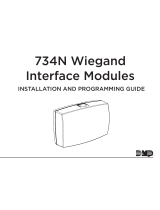 DMP Electronics 734N-POE Installation And Programming Manual
DMP Electronics 734N-POE Installation And Programming Manual
-
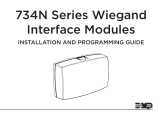 DMP Electronics 734N POE Firmware Installation guide
DMP Electronics 734N POE Firmware Installation guide
-
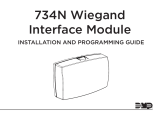 DMP Electronics 734N Wiegand Interface Module Installation guide
DMP Electronics 734N Wiegand Interface Module Installation guide
-
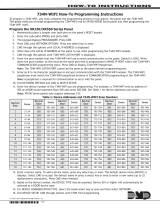 DMP Electronics 734N-WIFI How-To Manual
DMP Electronics 734N-WIFI How-To Manual
-
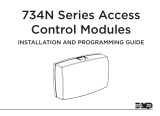 DMP Electronics 734N-POE Installation And Programming Manual
DMP Electronics 734N-POE Installation And Programming Manual
-
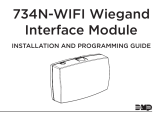 DMP Electronics 734N WiFi Installation guide
DMP Electronics 734N WiFi Installation guide
-
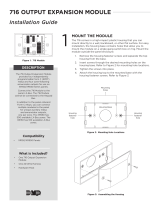 DMP Electronics 716 Installation guide
DMP Electronics 716 Installation guide
-
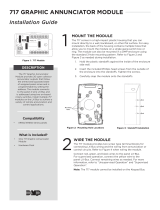 DMP Electronics 717 Installation guide
DMP Electronics 717 Installation guide
-
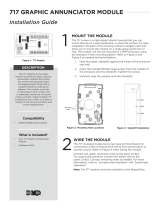 DMP Electronics 717 Installation guide
DMP Electronics 717 Installation guide
-
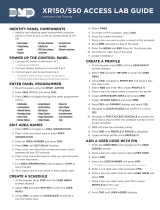 DMP Electronics XR550 series Quick start guide
DMP Electronics XR550 series Quick start guide
Other documents
-
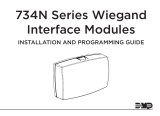 Digital Monitoring Products 734N Series Wiegand Interface Modules Programming Guide
Digital Monitoring Products 734N Series Wiegand Interface Modules Programming Guide
-
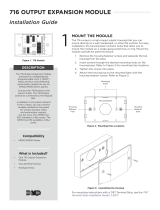 Digital Monitoring Products 716 Output Expansion Module Installation guide
Digital Monitoring Products 716 Output Expansion Module Installation guide
-
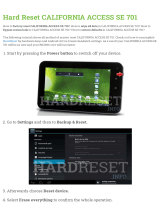 CALIFORNIA ACCESS SE 701 Hard reset manual
CALIFORNIA ACCESS SE 701 Hard reset manual
-
DMP LT-1232CAN Installation guide
-
Alarm Lock NETWORXPANEL Installation Instructions Manual
-
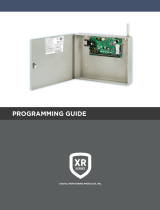 Digital Monitoring Products XR Series Installation & Programming Guides
Digital Monitoring Products XR Series Installation & Programming Guides
-
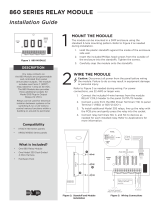 Digital Monitoring Products 860 Relay Output Module Installation guide
Digital Monitoring Products 860 Relay Output Module Installation guide
-
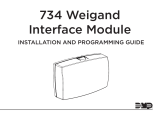 Digital Monitoring Products 734N 734N POE Firmware Installation guide
Digital Monitoring Products 734N 734N POE Firmware Installation guide
-
Sentry MBBRC Datasheet
-
 Digital Monitoring Products Firmware Installation guide
Digital Monitoring Products Firmware Installation guide


























